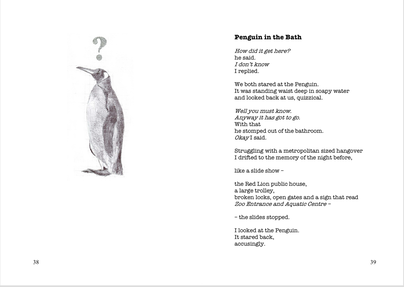THE WEAR AND TEAR OF CONVERSATION by Charlotte Harker
|
From "The Wear and Tear of Conversation"
|
Charlotte Harker is an artist and writer based in London. Her recent series of work has been made in a print studio with Shadwell Printmakers, London. Her drypoint prints which include portraits, architecture and trees are an extension of her drawing and painting based art practice. In 2017 she was the inaugural Artist in Residence at the William Heath Robinson Museum, Pinner, supported by a grant from Arts Council, England. In 2018/19 she was Artist in Residence at Victoria Park, London supported by the London Borough of Tower Hamlets, Victoria Park and Chisenhale Studios, London. Her writing is included in the 2017 and 2018 Poetry Anthologies published by Dempsey and Windle.
Her illustrated book The Wear and Tear of Conversation has extended her practice by combining her drawing and writing. In 2015 a series of her drawings was included in a book titled ‘Nowheres’, a collaborative project with the poet Tamar Yoseloff. This work was exhibited at the Poetry Society and also the Barbican Centre in 2015. In 2014, for her project and solo exhibition, ‘Species of Trees and Other Landscapes’ she was awarded a grant from Arts Council England. |
|
In 2012 Charlotte Harker was awarded a residency at the Cill Rialaig Project in Ballinskelligs, County Kerry, Ireland. In 2009 Arts Council England awarded a grant to support research into the work of 19th Century Landscape painter, Peter De Wint, at The Collection and Usher Gallery, Lincoln. Prior to that she was awarded a Pollock Krasner Foundation Grant in 2007. She has also been shortlisted for the Jerwood Drawing Prize.
As well as exhibiting across the U.K. including at the Dulwich Picture Gallery, Barbican Centre and the Jerwood Space, London, she has been in group shows in Europe, U.S.A. and Australia. Her work is in both public and private collections, including the collection of the British Psychotherapy Foundation, London, Kentish Town Health Centre, London, Bruce Castle, London and Queen Elizabeth’s School. ‘Charlotte's poetry takes me to a parallel world that is so much more interesting than the real one.
Her poems explore an absurd yet strangely plausible almost-reality.’ – Phil Lawder, Author |
ISBN 978-1-907435-65-2
148 x 210mm, 69 pages 30 poems and 44 drawings by Charlotte Harker RRP £9.00 |
'Giving voice to the unnoticed'
A review by Carla Scarano (first published in "Write Out Loud" (webzine)
Charlotte Harker’s The Wear and Tear of Conversation is an ironic and humorous account of the interactions between the self and its surroundings. She observes and depicts objects in limited interiors and explores language in relation to the referent, pointing out the equivocal and hilarious connections between ‘inanimate objects’ and words, using an almost animistic perspective. Each poem is related to a picture by the author, which explains the written text in a figurative simple way. This engages the reader in an intriguing double vision: realistic in the pictures, surreal in the poems.
[...]
Language reveals the breakdown of communication, the necessity to ‘repair’ it in some way. Worn out conversations produce worn out relationships, a contact with the other which should be renovated or renegotiated:
I noticed two paragraphs /on a ramp. / Words corrected, /indents repositioned /an adverb dismantled.//Outside I could hear the wear and tear of // conversation./Dialogue in need of repair.
(from ‘Sentence Repair Centre’)
A review by Carla Scarano (first published in "Write Out Loud" (webzine)
Charlotte Harker’s The Wear and Tear of Conversation is an ironic and humorous account of the interactions between the self and its surroundings. She observes and depicts objects in limited interiors and explores language in relation to the referent, pointing out the equivocal and hilarious connections between ‘inanimate objects’ and words, using an almost animistic perspective. Each poem is related to a picture by the author, which explains the written text in a figurative simple way. This engages the reader in an intriguing double vision: realistic in the pictures, surreal in the poems.
[...]
Language reveals the breakdown of communication, the necessity to ‘repair’ it in some way. Worn out conversations produce worn out relationships, a contact with the other which should be renovated or renegotiated:
I noticed two paragraphs /on a ramp. / Words corrected, /indents repositioned /an adverb dismantled.//Outside I could hear the wear and tear of // conversation./Dialogue in need of repair.
(from ‘Sentence Repair Centre’)



